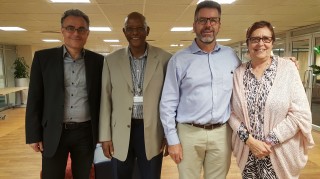
Department of Library Services Newsletter - Issue 3 - 2018

News and Events

The Department of Library Services hosted Dr Ralf Schimmer, Deputy Librarian and Head of Information at the Max Planck Digital Library and Mr Glenn Truran, Director of the South African National Library and Information Consortium (SANLiC)
The Department of Library Services hosted Dr Ralf Schimmer, Deputy Librarian and Head of Information at the Max Planck Digital Library and Mr Glenn Truran, Director of the South African National Library and Information Consortium (SANLiC) to discuss the Department of Library Services (DLS) transformation to open access (OA) in an information session in the library auditorium on 10 May 2018.
In his welcoming address, the library director, Mr Robert Moropa, noted that the attendees might wonder why it is important to hold a session on open access. He remarked that the biggest portion of the DLS budget went towards journal subscriptions. Any decisions regarding open access publications would therefore influence the library business. He continued by saying that the DLS wanted to support the OA2020 initiative.
Dr Ralf Schimmer, the first guest speaker, presented on “OA2020 – initiative for the large-scale transformation to open access.” Dr Schimmer covered the grounding of OA2020. OA2020 is a global alliance committed to accelerating the transition to open access. Their mission is to collaborate to transform the current publishing system, replacing the subscription business model with new models that ensure outputs are open and re-usable and that the costs behind their dissemination are transparent and economically sustainable. Dr Schimmer reiterated that the basic idea of OA is simple: make research literature available online without price barriers and free of most permission barriers. Even the implementation is so simple that the volume of peer-reviewed OA literature and the number of institutions providing it have grown at a steady rate for more than a decade. It is disheartening that the OA movement is strong as a principle but still fairly weak as a practice with a low deposit rate in institutional repositories and only 15% of research immediately available in OA mode. Even more troubling is that the subscription system is as prosperous as ever.
Dr Schimmer suggested that our money should be used as a new leverage as there is more than enough money in the system. He proposed an orderly transition: OA on a large scale can only be accomplished if and as soon as we change the business model of the existing scholarly journals and leave the subscription system behind. The pursuant disruptions would affect only the underlying cash flows, rather than the publishing process itself or the roles of journals and publishers. By re-organizing the money flow, journals can successfully be flipped to an open model. He ended off by encouraging the DLS to express interest in OA2020 and to take action by developing national, regional and institutional roadmaps with practical steps to drive the transition. The ultimate goal is to engage all key publishers in transitional, transformative agreements by 2020.
Mr Glenn Truran, the second presenter, gave an overview of the 2017 SANLiC report. The main role of SANLiC is to assist member institutions to acquire a better deal with publishers and harness the collective buying power of institutions to negotiate license agreements for digital content. In his presentation, Mr Truran shared information regarding the University of Pretoria (UP) journal subscription expenses. UP has the second largest number of journal subscriptions of all South African academic libraries. The largest part of the library’s subscription budget is spent on five publishing deals, namely Science Direct, Wiley, Springer Nature, Taylor & Francis and Sage. He encouraged the DLS to support OA2020.
Mr Truran also highlighted the challenges in finding a suitable subscription model that supports open access. In this regard, he referred to the SCOAP3 (The Sponsoring Consortium for Open Access Publishing in Particle Physics) model as an example of how to achieve “gold” open access to high-quality journals. The SCOAP3 model is based on a lightweight central administration, which arranges payment of Article Processing Charges (APCs) at a competitive level, through funds made available from a redirection of former subscription money. Participating libraries redirect the money previously used for subscribing to the SCOAP3 journals into a common fund, from which the publication costs are paid. This redirection is possible as all publishers are reducing or eliminating subscription costs to the SCOAP3 journals and credit all their clients respectively. The University of Pretoria is one of the over three thousand libraries participating in SCOAP3.
Both presentations highlighted the complexities of open access, which emphasise the importance of collaborative initiatives to find solutions that will benefit all role players in the scholarly publications system.
For more information: https://oa2020.org/be-informed/#why
The link to Dr Ralf Schimmer’s presentation: http://hdl.handle.net/2263/67165
- Author: Elsabé Olivier and Marguerite Nel The Library co-ordinated and presented experiential learning courses to Information Science students
The Library co-ordinated and presented experiential learning courses to Information Science students
Conferences
Visitors
Staff News
Enquiries can be directed to Mrs Elsabé Olivier (email: [email protected])
























